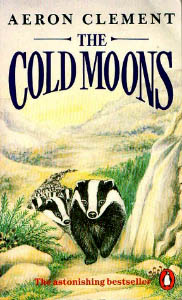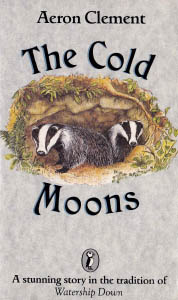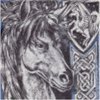Review: 'The Cold Moons' by Aeron Clement
 You might think, on first glance, that you might not enjoy this 1987 book due to its similarity to Richard Adam's 1972 classic, Watership Down. That's why it sat on my shelf for almost a decade collecting dust, until recently when I felt the need to dip into some more children's literature.
You might think, on first glance, that you might not enjoy this 1987 book due to its similarity to Richard Adam's 1972 classic, Watership Down. That's why it sat on my shelf for almost a decade collecting dust, until recently when I felt the need to dip into some more children's literature.
The barebones plot has a group of small, harmless animals, displaced from their homes by man. A group of survivors venture out into the unknown (and very British) countryside with a Moses-like leader. There are trials and tribulations, including a conflict with their own kind, and eventually they find the promised land where they can live in peace... at least for a few generations.
I found The Cold Moons to be equal to, if not superior to Watership Down. Part of what makes it an interesting and intriguing story is a tie-in to a real-life event. In the early 1970s, the British government was convinced that outbreaks of tuberculosis in cattle were due to diseased badgers. This view was fostered by a conservative newspaper, apparently run by a cousin of J. Jonah Jameson. Without much research, the government ordered the extermination of every last badger in England. Teams went out with the precision of engineers.
They would find a sett (a badger's den), block all the exits they could find, and pump in cyanide gas to produce a slow and painful death. They worked in an orderly fashion from south to north. At first, they had limited resources. Later, they brought in helicopters and trackers. These extermination teams are the people that the badgers in the book are fleeing from.
In place of Watership Down's Hazel, we have Buckwheat. Like Hazel, Buckwheat is warned that disaster is coming. Unlike the rabbits' story, it's not a mystic dreamer who acts as a harbinger, but a scarred badger named Bamber that somehow escapes an extinction patrol.
The entire first chapter is dedicated to Bamber's happy life with his mate, Dainty, and her death. The shift in tone from sweet to sour is as realistic as any death scene I've read. His whole tribe, wiped out... and this is in the first 9 pages. His sole goal is to survive, find more of his kind, and warn them that the humans have gone crazy.
 Thus begins a quest for Elysia. One of the overriding themes is of Legacy. The Legacy that Bambers gives to Buckwheat. The Legacy that Buckwheat, in turn, passes to his son Beaufort. The Legacy that Beaufort has to fight to keep.
Thus begins a quest for Elysia. One of the overriding themes is of Legacy. The Legacy that Bambers gives to Buckwheat. The Legacy that Buckwheat, in turn, passes to his son Beaufort. The Legacy that Beaufort has to fight to keep.
Because of Bamber's sacrifice, almost 200 badgers escape death. I had no idea badgers were so social. Rather than the mere dozen rabbits in Watership Down trying to rebuild their warren, the entire power structure of the badgers is intact, and that creates a lot of wonderful plot points. You can see different badgers grow (and fail)... including a corrupt, power-hungry one who's willing to kill most of the others just to make sure that he gets his way.
I enjoyed this book greatly, although I didn't care too much for the insertion of newspaper articles about the fleeing badgers and the efforts to kill them all. However, the insertions were helpful in following the rising tide of public opinion that eventually resulted in the critters becoming a protected species. It kept me from becoming too cynical about the end of the book; so I shouldn't complain.
The Cold Moons has been out of print since 1990; you may have to check your local library, or shop for an old copy from sites such as AbeBooks. Badgers and tuberculosis in Britain are still a subject of recent concern.

About the author
Greyflank (Bill Kieffer) — read stories — contact (login required)a typing horse in a cube farm and Rough Draft Horse from Jersey Shore, NJ, interested in furry, transformation and thinking about crazy people...
In 2015, I've had three short stories published in Inhuman Acts, An Anthropomorphic Century, and NSFW.
In 2016, Red Ferret Press published my adult TF novel, The Goat: Building a Perfect Victim. It won the 2016 Coyotl Award.
In 2017, I'm averaging about three short stories published a year.
Comments
I read this a long time ago, and the thing I remember most about it is that it has no dialogue. The badgers are described as communicating, without using speech. It was an interesting contrast to the other animal fiction I had read at the time, like Watership Down and Duncton Wood.
I also read it a long time ago. (I reviewed it for Yarf! in 1990.) I also criticized its lack of dialogue, but on the whole I liked it, and I still recommend it. I’m glad to see that it’s still available, at least from Amazon.uk. (But watch out for spell checkers that change “Aeron” to “Apron”.)
http://anthrozine.com/site/lbry/yarf.reviews.3.html
https://www.amazon.co.uk/Cold-Moons-Aeron-Clement/dp/0140116265/ref=sr_1_1?s=boo...
https://www.amazon.co.uk/Cold-Moons-Aeron-Clement/dp/B001KTOOF2/ref=sr_1_4?s=boo...
Fred Patten
P.S.: I have also personally met a badger in the wild. Either it was having a bad day, or they're generally nasty buggers.
Fred Patten
It sounds pretty cool. The plot sounds like pretty standard for animal fiction in that period. It was all how evil man was and cute animals fleeing to a new home. Farthing Wood did the same thing.
"If all mankind minus one, were of one opinion, and only one person were of the contrary opinion, mankind would be no more justified in silencing that one person, than he, if he had the power, would be justified in silencing mankind."
~John Stuart Mill~
True, and not without merit, as in this case the events are truthfully retelling an event that seems engineered to simply sell newspapers.
I am large grey draft horse. Currently, I am attempting to raise funds due to a death in my family. https://www.gofundme.com/u772rx-rons-funeral-expenses
Post new comment